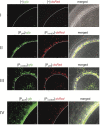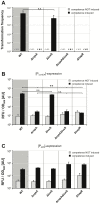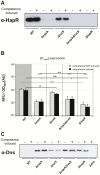The regulatory network of natural competence and transformation of Vibrio cholerae
- PMID: 22737089
- PMCID: PMC3380833
- DOI: 10.1371/journal.pgen.1002778
The regulatory network of natural competence and transformation of Vibrio cholerae
Abstract
The human pathogen Vibrio cholerae is an aquatic bacterium frequently encountered in rivers, lakes, estuaries, and coastal regions. Within these environmental reservoirs, the bacterium is often found associated with zooplankton and more specifically with their chitinous exoskeleton. Upon growth on such chitinous surfaces, V. cholerae initiates a developmental program termed "natural competence for genetic transformation." Natural competence for transformation is a mode of horizontal gene transfer in bacteria and contributes to the maintenance and evolution of bacterial genomes. In this study, we investigated competence gene expression within this organism at the single cell level. We provide evidence that under homogeneous inducing conditions the majority of the cells express competence genes. A more heterogeneous expression pattern was observable on chitin surfaces. We hypothesize that this was the case due to the heterogeneity around the chitin surface, which might vary extensively with respect to chitin degradation products and autoinducers; these molecules contribute to competence induction based on carbon catabolite repression and quorum-sensing pathways, respectively. Therefore, we investigated the contribution of these two signaling pathways to natural competence in detail using natural transformation assays, transcriptional reporter fusions, quantitative RT-PCR, and immunological detection of protein levels using Western blot analysis. The results illustrate that all tested competence genes are dependent on the transformation regulator TfoX. Furthermore, intracellular cAMP levels play a major role in natural transformation. Finally, we demonstrate that only a minority of genes involved in natural transformation are regulated in a quorum-sensing-dependent manner and that these genes determine the fate of the surrounding DNA. We conclude with a model of the regulatory circuit of chitin-induced natural competence in V. cholerae.
Conflict of interest statement
The authors have declared that no competing interests exist.
Figures







Similar articles
-
A transcriptional regulator linking quorum sensing and chitin induction to render Vibrio cholerae naturally transformable.Nucleic Acids Res. 2013 Apr 1;41(6):3644-58. doi: 10.1093/nar/gkt041. Epub 2013 Feb 4. Nucleic Acids Res. 2013. PMID: 23382174 Free PMC article.
-
Regulatory elements involved in the expression of competence genes in naturally transformable Vibrio cholerae.BMC Microbiol. 2014 Dec 24;14:327. doi: 10.1186/s12866-014-0327-y. BMC Microbiol. 2014. PMID: 25539806 Free PMC article.
-
Chitin colonization, chitin degradation and chitin-induced natural competence of Vibrio cholerae are subject to catabolite repression.Environ Microbiol. 2012 Aug;14(8):1898-912. doi: 10.1111/j.1462-2920.2011.02689.x. Epub 2012 Jan 6. Environ Microbiol. 2012. PMID: 22222000
-
Regulation of competence-mediated horizontal gene transfer in the natural habitat of Vibrio cholerae.Curr Opin Microbiol. 2016 Apr;30:1-7. doi: 10.1016/j.mib.2015.10.007. Epub 2015 Nov 23. Curr Opin Microbiol. 2016. PMID: 26615332 Review.
-
Chitin and Products of Its Hydrolysis in Vibrio cholerae Ecology.Biochemistry (Mosc). 2015 Sep;80(9):1109-16. doi: 10.1134/S0006297915090023. Biochemistry (Mosc). 2015. PMID: 26555464 Review.
Cited by
-
Functionality of Two Origins of Replication in Vibrio cholerae Strains With a Single Chromosome.Front Microbiol. 2018 Nov 30;9:2932. doi: 10.3389/fmicb.2018.02932. eCollection 2018. Front Microbiol. 2018. PMID: 30559732 Free PMC article.
-
The coordinated replication of Vibrio cholerae's two chromosomes required the acquisition of a unique domain by the RctB initiator.Nucleic Acids Res. 2021 Nov 8;49(19):11119-11133. doi: 10.1093/nar/gkab903. Nucleic Acids Res. 2021. PMID: 34643717 Free PMC article.
-
ComM is a hexameric helicase that promotes branch migration during natural transformation in diverse Gram-negative species.Nucleic Acids Res. 2018 Jul 6;46(12):6099-6111. doi: 10.1093/nar/gky343. Nucleic Acids Res. 2018. PMID: 29722872 Free PMC article.
-
The emergence of Vibrio pathogens in Europe: ecology, evolution, and pathogenesis (Paris, 11-12th March 2015).Front Microbiol. 2015 Aug 13;6:830. doi: 10.3389/fmicb.2015.00830. eCollection 2015. Front Microbiol. 2015. PMID: 26322036 Free PMC article.
-
Multiple Pathways of Genome Plasticity Leading to Development of Antibiotic Resistance.Antibiotics (Basel). 2013 May 30;2(2):288-315. doi: 10.3390/antibiotics2020288. Antibiotics (Basel). 2013. PMID: 27029305 Free PMC article. Review.
References
-
- Bertuzzo E, Mari L, Righetto L, Gatto M, Casagrandi R, et al. Prediction of the spatial evolution and effects of control measures for the unfolding Haiti cholera outbreak. Geophys Res Lett. 2011;38 doi:10.1029/2011GL046823.
-
- Tuite AR, Tien J, Eisenberg M, Earn DJ, Ma J, et al. Cholera Epidemic in Haiti, 2010: Using a Transmission Model to Explain Spatial Spread of Disease and Identify Optimal Control Interventions. Ann Intern Med. 2011;154:593–601. - PubMed
-
- Rinaldo A, Blokesch M, Bertuzzo E, Mari L, Righetto L, et al. A transmission model of the 2010 cholera epidemic in haiti. Ann Intern Med. 2011;155:403–404. - PubMed
Publication types
MeSH terms
Substances
LinkOut - more resources
Full Text Sources

